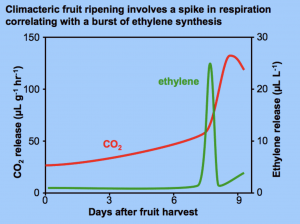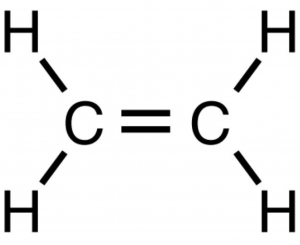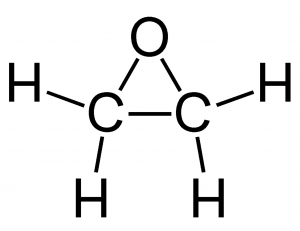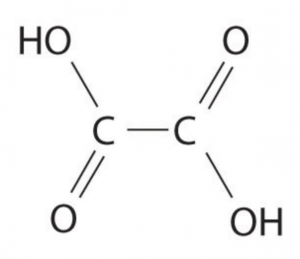Have you heard the Banana Thing – the one about the banana in the beehive?
While there is ‘anecdotal evidence’ for bananas as a cure for chalkbrood – it is not scientifically proven.
However, it isn’t scientifically disproven either and there’s no smoke without fire. Read on…
Here is the usual response to the Banana Thing:
But like smoke without fire – could there be something to it?
Just so we know what we’re talking about – here’s the recipe:
Recipe
- Cut an unpeeled banana in half lengthways;
- Sit the two halves – cut side uppermost – on the top bars of the brood box;
- Add a 1″ eke if need be;
- Replace the crownboard;
- Close the Varroa floor;
- Leave alone for 1 month;
- When you come back the chalk brood will be gone. Apparently.
But what is the mechanism?
It could be:
- Hygienic behaviour;
- Alarm Pheromone mimicry;
- Ethylene;
- Ethylene breakdown product;
- Something else;
- One of the above, several of the above, all of the above or none of them.
Hygienic Behaviour
We all express hygienic behaviour – even me. Like if you get a whiff of something horrible – you check your shoes and if they’re clear you conclude you imagined it. If you get another whiff you look further afield – somebody else’s shoes, under the table perhaps, or behind the settee. If there’s still nothing you might assume it came in through the window but when you get that third whiff you really go into overdrive: you get the torch out and the rubber gloves on.
That is hygienic behaviour but when the bees do it – there’s more of them and they don’t wait for the third whiff – they just go bananas at the first one.
Alarm Pheromone
With bees, the horrible smell could be simply that rotting banana smell – we all know they have a short fuse. However, I read somewhere that bee alarm pheromone smells like bananas and I remember hearing of somebody who came into close contact with savage Africanised bees – he was well protected inside a strong beesuit but the bees were going bananas stinging the suit and I remember him saying there was a smell like bananas. I’ve also heard it said – don’t eat bananas before going to your bees because they don’t like it and perhaps that’s why. That’s more anecdotal stuff for you.
Either way, perhaps the smell of alarm pheromone puts the bees into a state of heightened awareness and who knows how that might be expressed; they might reach for the rubber gloves and the torch.
Ethylene
If you put a ripe banana in a paper bag with an Unripe Thing – the banana will ripen the Unripe Thing. This is because ripening bananas are a source of ethylene which is a gas and also a plant hormone. 7 days after the banana leaves the cooler and hits peak-ripeness the ethylene production spikes thus:

If at this point your banana and your unripe thing are in the bag together – the ethylene will tell the unripe thing to get ripe – and it will, because as we said, ethylene is a plant hormone and plants do as they are hormonally instructed. This is a scientifically proven fact by the way – not an anecdote.
If you further enclose your paper bag of fruits in plastic bag this will prevent the escape of ethylene and the effects will be more pronounced as ethylene causes more ethylene to be produced. This has implications for the banana chalkbrood thing and if you try it you should refrain from looking under the crownboard or you will release the ethylene.
Fruit ripeners use ethylene commercially to ripen fruit and fruit merchants will chemically remove ethylene from refrigerated units to help preserve it.
What has this to do with chalkbrood says you? Well for one thing it shows you that ethylene itself is a chemical that can provoke a reaction in plants.
In the presence of oxygen, ethylene can degrade to other interesting chemicals.
Ethylene Degradation Path
- Ethylene C2H4 ->
- Ethylene oxide C2H4O ->
- Oxalic acid C2H2O4 ->
- 2 CO2

In the presence of oxygen, ethylene degrades to ethylene oxide – another gas but one which is used as a fumigant to kill fungi on stored grain and artefacts in museums. Also insects!

More importantly, ethylene oxide has been shown to decontaminate honeybee larvae killed by chalkbrood. There’s interesting!
Click here for a look at that paper
The ethylene oxide further degrades to oxalic acid and we know what that does. To Varroa anyway.

But is the degradation spontaneous – that’s what I’d like to know.
Is there a Chemist in the house…?
Experiment
There’s enough there to arouse my curiosity so rather than just dismiss it as a myth let’s try it and see what happens. It just so happens that I’ve got a hive of bees here with bad chalkbrood …. I’ll let you know what happens but that will be more anecdotal evidence.
Click here for chalkbrood and the banana results
Click here for more about Chalkbrood on this site
Click here for Chalkbrood on DaveCushman’s site
Click here for more on Ethylene gas
Click here for Ethylene as a plant hormone
Gochnauer, T. A. & Margetts,V. J. (1980) Decontaminating Effect of Ethylene Oxide on Honeybee Larvae Previously Killed by Chalk-Brood Disease. Journal of Apicultural Research. 19: 261-264

All plants do that https://www.google.com/search?client=opera&q=ethylene&sourceid=opera&ie=UTF-8&oe=UTF-8
Yes, they do
Thanks, one theory is that the banana triggers a super cleaning response…
Another suggests coating banana with icing sugar.
Keeping effected colony in the henhouse will see the chooks clean up discarded mummies.
So, what happened with the banana skin treatment?
Good question, inconclusive results here: http://beespoke.info/2016/10/26/chalkbrood-banana-results/
More research needed I think but the main thing is that the bees didn’t seem to suffer at all so it’s something to try and it’s fun.